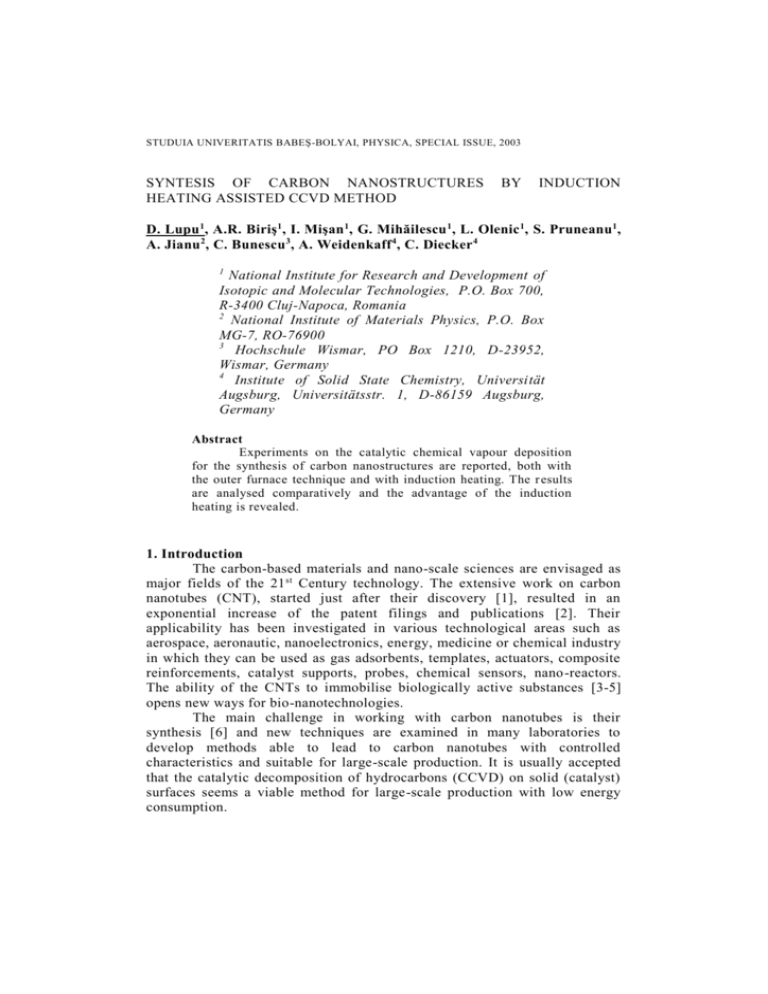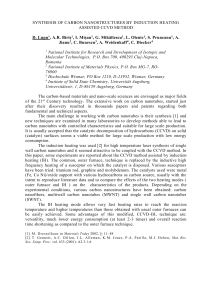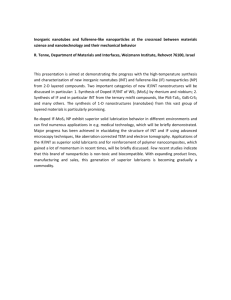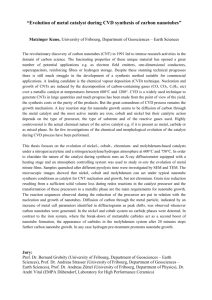1. Introduction
advertisement

STUDUIA UNIVERITATIS BABEŞ-BOLYAI, PHYSICA, SPECIAL ISSUE, 2003 SYNTESIS OF CARBON NANOSTRUCTURES HEATING ASSISTED CCVD METHOD BY INDUCTION D. Lupu 1, A.R. Biriş 1 , I. Mişan 1, G. Mihăilescu 1 , L. Olenic 1, S. Pruneanu 1, A. Jianu 2, C. Bunescu 3, A. Weidenkaff 4, C. Diecker 4 1 National Institute for Research and Development of Isotopic and Molecular Technologies, P.O. Box 700, R-3400 Cluj-Napoca, Romania 2 National Institute of Materials Physics, P.O. Box MG-7, RO-76900 3 Hochschule Wismar, PO Box 1210, D-23952, Wismar, Germany 4 Institute of Solid State Chemistry, Universität Augsburg, Universitätsstr. 1, D-86159 Augsburg, Germany Abstract Experiments on the catalytic chemical vapour deposition for the synthesis of carbon nanostructures are reported, both with the outer furnace technique and with induction heating. The r esults are analysed comparatively and the advantage of the induction heating is revealed. 1. Introduction The carbon-based materials and nano-scale sciences are envisaged as major fields of the 21 st Century technology. The extensive work on carbon nanotubes (CNT), started just after their discovery [1], resulted in an exponential increase of the patent filings and publications [2]. Their applicability has been investigated in various technological areas such as aerospace, aeronautic, nanoelectronics, energy, medicine or chemical industry in which they can be used as gas adsorbents, templates, actuators, composite reinforcements, catalyst supports, probes, chemical sensors, nano-reactors. The ability of the CNTs to immobilise biologically active substances [3-5] opens new ways for bio-nanotechnologies. The main challenge in working with carbon nanotubes is their synthesis [6] and new techniques are examined in many laboratories to develop methods able to lead to carbon nanotubes with controlled characteristics and suitable for large-scale production. It is usually accepted that the catalytic decomposition of hydrocarbons (CCVD) on solid (catalyst) surfaces seems a viable method for large-scale production with low energy consumption. D. LUPU ET AL. The use of the induction heating to reach high temperatures during the laser synthesis of single-wall carbon nanotubes [7] pointed out to the ability of this particular heating mode to control the temperature of the reaction even at high temperatures, without significant heat transfer to the quartz tube confining the reaction region. This made us to explore the possibilities of coupling the induction heating (IH) with the CCVD method for the synthesis of carbon nanotubes. By this CCVD-IH route, various types of carbon nanostructures were indeed obtained [8], the attempts showing that it can be used even for the vertical, floating catalyst method. In this paper, the results obtained with outer furnace technique and induction heating, keeping the same all the other reaction conditions (hydrocarbon and carrier gas flow, reaction temperature and time) are comparatively reported, trying to find out some possible advantages of the CCVD-IH coupling. 2. The experimental set-up of CCVD with induction heating The catalytic chemical vapor decomposition of hydrocarbons for the synthesis of carbon nanofibers, single-wall nanotubes (SWNT), multi-wall nanotubes (MWNT) is usually performed at temperatures over 500 oC, in a Pressure gage (0 , 10 bar) Flow meters Hydrocarbon Inductor Coil Pressure gage ( -1 , 0 bar) Gas output Gas input Catalyst susceptor Vacuum Quartz tube Hydrogen ( Hydrocarbo 99,9999% ) n Carrier gas Fig.1. Scheme of the experimental set-up for CCVD syntheses of carbon nanostructures using induction heating quartz tube containing the catalyst which may be displayed in a covenient way to be kept at the reaction temperature. In our experiments, both heating with an electric outer furnace (refered to as CCVD) and induction heating (CCVD-IH) have been used. In the later, the outer furnace has been r eplaced by the coils of an high frequency inductor working at 1.3 MHz as described in SYNTHESIS OF CARBON NANOSTRUCTURES BY INDUCTION HEATING ASSISTED CCVD Fig. 1. The catalyst is placed on the susceptor within the quartz tube – an electric conductor of suitable shape which can be inductively heated. Some peculiarities of the two heating modes need a brief review. The heating of the catalyst (either as a powder in a ceramic boat or deposited on a substrate) with an outer furnace is achieved through heat transfer by radiation and convection from the hot tube walls. Conversely, in the induction heating case, the thermal gradient is in the opposite direction: the heat transfer flows from the inductively heated susceptor to the catalyst displayed on its surface. The inductive heating (IH) occurs due to the confinement of the induced currents and magnetic flux to a thin layer of an electric conductor subjected to the high-frequency field- the skin effect. The thickness of this layer decreases with the increasing frequency, at high frequencies the electromagnetic energy beeing confined essentially to the surface [9] with the skin depth depending on the frequency, relative permeability and electric conductivity – the parameters on which the selection of a suitable susceptor should depend on. Due to the permeability, for example, the skin depth of magnetic steel increase from 0.014 mm below the Curie point to 0.55 mm above 780 oC. The power absorbed by the IH heated body depends on the same parameters and on the magnetic field. Because the catalyst involves metallic clust ers it may be directly influenced by the high-frequency field with direct consequences on the processes related to the CCVD occuring on its surface. These effects, which are not present in the conventional heating mode, may ultimately result in influences on the morphology and growth of the carbon nanostructures synthesized by CCVD-IH. The experiments showed that the materials used for the susceptor can be titanium, graphite, molybdenum or even iron. With the modified CCVD-IH method, the activation of the catalyst can be performed also at the desired temperature as for the CCVD with outer furnace technique, by the control of the high-frequency generator at the required conditions. 3. Comparative results obtained by CCVD and CCVD-IH 3.1 Hollow core nanofibers With a Ti rod used as a susceptor, its surface was previously prepared to obtain a thin layer of TiO 2 as the titanium oxide proved to be good as support of metal catalyst [10] for the synthesis of carbon nanostructures. The surface of the rod was oxidized electrochemically in a 3% aqueous solution at constant voltage (20 V, DC) for 10 min. After that, nitrate solutios were evaporated to obtain Fe:Co (1:1 mole ratio)/TiO 2 and the deposit was heated in air at 400 oC for 1 h. Both for the CCVD and CCVD-IH synthesis, the catalyst was previously activated “in situ” at 350 o C for 1 h, after which the temperature of the rod was increased at 600 o C and an ethylene:hydrogen D. LUPU ET AL. mixture (4:1 volume ratio) at 0.35 bar was admitted in the quartz tube. After 1 h, the sample was cooled to the room temperature. The carbonaceous products, collected by scraping from the Ti rod were maintained in HCl 37% for 24 h, washed with distilled water and dried at 150 oC for 1h. The results reported comparatively in Fig. 2 for synthesis in exactly the same conditions show some interesting differences. Hollow core nanofibers of 20-50 nm o.d. (5-20 nm i.d.) many of them with catalyst particles encapsulated at their tips are obtained by CCVD. On the other hand, CCVD-IH results in significantly thinner nanofibers of 8-15 nm o.d. (3-5 nm i.d.), without catalyst particles at the tip. This suggests a higher growth rate in the IH case as the thin fibers grow faster than the thick ones [11]. Further studies seem very interesting to elucidate if this might be a direct effect of the induction currents. a b Fig.2. TEM images of the carbon nanostructures obtained in the same reaction conditions from ethylene:hydrogen (4:1) at 0.35 bar and 600 o C on Fe:Co(1:1)/TiO 2, using: a) outer furnace and b) induction heating 3.2 Single wall nanotubes Experiments on the synthesis of SWNT have been also performed, using the Fe:Mo:Al 2O3 (1:0.2:16 weight ratios) reported in literature [12] to be good for SWNT synthesis even without activation. The catalyst was prepared as described [12] and 20-30 mg were introduced in a graphite cylinder of 14 mm o.d. (1 mm wall thickness) as susceptor. The synthesis was conducted at 800 oC with 12 ml/min methane flow and 80 ml/min purified argon as carrier gas for 1 h after which the sample was allowed to cool at the room temperature. Fig.39a,b) show images very similar to the bundles of SWNT reported in [7]. They are more abundant in the case of CCVD-IH (Fig. 3b) as compared to the outer furnace technique (Fig. 3a). Raman studies will SYNTHESIS OF CARBON NANOSTRUCTURES BY INDUCTION HEATING ASSISTED CCVD be performed to obtain more detailed informations about the SWNTs diameters and some possible differences between the two methods. a b Fig.3. TEM images for as-prepared carbon nanotubes from methane/argon at 800 o C on Fe:Mo:Al 2 O3 catalyst by: a) CCVD and b)CCVD-IH techniques The average yield was 19-20% both for CCVD and for CCVD-IH but the consumed energy was 2.5 kWh for CCVD aand only 0.6 kWh for IH. 3.3 Multi-wall nanotubes With CCVD-IH, thin hollow core nanofibers of 15-20 nm outer diameter, 5-6 nm inner hollow core, (possibly MWNT), were obtained from ethylene (16% vol) in hydrogen flow (100 ml/min) at 600 o C with Ni/Al 2 O3 on molybdenum susceptor. The catalyst was prepared by evaporating Ni and Al nitrates on a rolled Mo foil. The TEM image shown in Fig. 4 does not allow a firm conclusion about the identification as MWNT and the work needs to be Fig.4. TEM image of carbon continued by HRTEM studies. nanostructures obtained by CCVD-IH from Recently it was reported o ethylene: hydrogen (16 % vol) at 600 C [13] that high quality multi-wall on Ni/Al 2O 3 carbon nanotubes are obtained from acetylene on Co 3 O4/MgO catalyst with nitrogen as carrier gas. Preliminary results, within a cooperation with Prof. L. D. LUPU ET AL. Duclaux and Dr. Y. Soneda, show that in the same reaction conditions, better MWNT are obtained with the CCVD-IH method [14], as revealed by HRTEM. The work is now in progress to establish the suitable synthesis conditions and to characterize the morphology and structure of the products. It is worth to note that the energy consumed in this case, even using a short electric outer furnace is 420 Wh for CCVD but only 175 Wh for CCVD-IH. Conclusions The induction heating can be used to synthesize all the main type of carbon nanostructures (nanofibers, SWNT, MWNT) by the CCVD method. This CCVD-IH method show some advantages as compared to the outer furnace technique: 2-3 times lower energy consumption, lowering of the overall time for a batch due to the fast heating and cooling rates, versatility in the temperature control with much higher temperatures available for synthesis and thermal annealing, reduced extent of the heating zone. The influence of IH on the morphology, structure and growth rate of the carbon nanostructures deserves further studies. References [1]. S. Iijima, Nature 354(1991)56 [2]. R.H. Baughman, A.A. Zakhidov, W.A. de Heer, Science 297(2002)787 [3]. G.A. Kovalenko, E.V. Kuznetsova, Yu.I. Mogilnykh, I.S. Andreeva, D.G. Kuvshinov, N.A. Rudina, Carbon 39(2001)1033 [4]. X. Yu, D. Chattopadhyay, I. Galeska, F. Papadimitrakopoulos, J.F. Rusling, Electrochemistry Communications 5(2003)408 [5]. W. Huang, S. Taylor, K. Fu, D. Zhang, T.W. Hanks, A. M. Rao, Y-P. Sun, Nano Letters 2(2002)311 [6]. M. Dresselhaus in Materials Today 2002, 5: 11: 48 [7]. T. Gennett, A.C. Dillon, J.L. Alleman, K.M. Jones, P.A. Parilla, M.J. Heben, Mat. Res. Soc. Symp. Proc. vol. 633 (2001): A2.3.1-6 [8]. D. Lupu, A.R. Biris, A. Jianu, C.Bunescu, E. Burkel, E. Indrea, G. Mihailescu, S. Pruneanu, L. Olenic, I. Misan, Carbon (2003) accepted for publication [9]. C.P. Poole Jr., Electron spin resonance, New York, John Wiley Ed. 1967, pp7273 [10]. S. Takenaka, H. Ogihara, I. Yamanaka, K. Otsuka, Applied Catalysis A 217(2001)101 [11]. K.P. de Jong, J.W. Geus, Catalysis Review-Sci. and Eng. 42(2000)481 [12]. A.R. Harutyunyan, B.K. Pradhan, U.J. Kim, G. Chen, P.C. Eklund, Nano Letters 2(2002)525 [13]. Y. Soneda, L. Duclaux, F. Beguin, Carbon 40(2002)965 [14]. Y. Soneda, private communication






